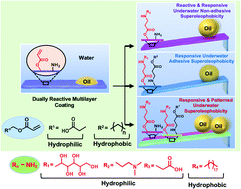Dually reactive multilayer coatings enable orthogonal manipulation of underwater superoleophobicity and oil adhesion via post-functionalization†
Abstract
Fish scale-inspired underwater superoleophobic coatings with low oil adhesion can be achieved through the creation of hierarchical surface topography on water-compatible materials (including polymeric hydrogels, metal oxides, and electrostatic multilayers). While promising, these method do not allow for the underwater superoleophobicity and oil adhesion to be independently tuned, limiting their potential applications. Here we report the design of a conceptually novel class of coatings, dually reactive multilayer coatings, whose underwater superoleophobicity and oil adhesion can be independently tuned through the orthogonal functionalization of two types of reactive moieties at ambient conditions. Moreover, the cooperative assembly of amphiphiles on the modified underwater superoleophobic coating gives rise to a switchable oil adhesion while retaining the extreme oil-repellency (advancing oil contact angle >165°). Interestingly, the reversible change in the oil adhesion of the underwater superoleophobic coatings depends on the interplay between the molecular structure and concentration of the amphiphiles and the pH of the aqueous solution. Building on these findings, we developed superoleophobic sensors that enable the real-time and naked eye identification of (1) the charge of synthetic ionic surfactants and (2) the concentration of bile acids. Overall, the results reported in this work provide design principles by which molecular self-assembly and oil adhesion can be coupled at underwater superoleophobic surfaces, and hint at principles by which physiologically important amphiphiles and metabolites can be rapidly sensed with the naked eye using our novel class of superoleophobic surfaces.



 Please wait while we load your content...
Please wait while we load your content...